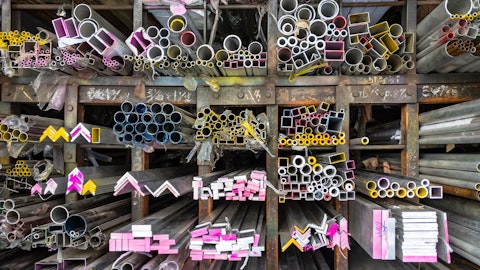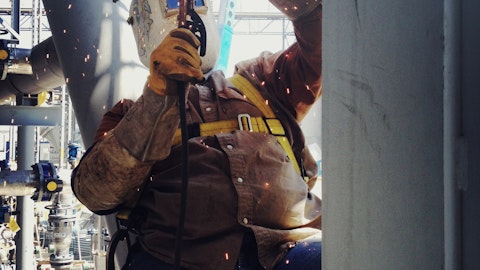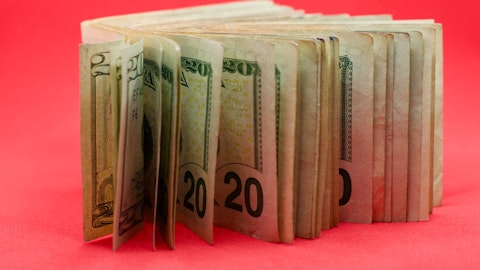TimKnavish: Yes. Duffy, this is Tim. I’ll do the auto one. I’ll let Vince do the cash versus EBITDA one. Auto had a really good year for us last year, and we are well positioned for what we view as a multiyear recovery. So I personally continue to be bullish on auto as we look into the full year 2024, when you look at our Q1, and we went from up mid-single digits in Q4, and we’re projecting low single-digits down in Q1, a lot of that, if you go back to last year, we were a strong double-digit up in Q1 of 2023. And also, yes, there is some, as I mentioned in my opening remarks, we do have some of our index pricing rolling back and that has some impact. But I would not — personally, I’m not overconcerned about auto volumes as we move through the year.
I think total builds were 89-point-something last year. I believe there is some incremental upside to that as we move through 2024. Our share position is good. Our China auto position is really good. And as you know, out of the 90 million new builds, about 30 million will come out of China. So overall, feeling good about auto. There’s a little bit of a year-over-year comp soft point and a little bit of index pricing rolling off in Q1.
Vince Morales: Just to add, as we talked several times, Duffy, on auto, acceleration in China helps us from an EV perspective as well. So we have more content on any traditional EV than we do otherwise. So that’s proper for us in PPG in particular. To your cash flow question yes, I think the short answer is typically EBITDA would certainly serve as a proxy for cash flow, plus or minus. We have the last couple of years, expanded answer is we have the last couple of years had working capital movement that has either helped or hurt the cash flow on a transitory basis. We do have, as Tim alluded to in his opening comments, probably a couple of hundred million dollars of excess raw materials in inventory. We’re going to work that down in 2024. So that will have a cash flow implication for us in a positive manner. But I think generally, what you’re saying in EBITDA and cash flow should be the movement should be consistent.
TimKnavish: Yes. And Duffy, this is Tim. I’m going to come back with one additional — Vince mentioned the EV situation. And we all see the headlines on EVs, but that’s largely U.S. and Europe right now. And as you know, two-thirds of the world’s EVs are made in China, and that content number, if you look at the average PPG content across the EV space for 2023, was up by 20%. So our content per EV built was up by 20% in 2023. So that bodes well for us as well.
Operator: Our next question comes from Stephen Byrne with Bank of America/Merrill Lynch. Your line is open. Please go ahead.
Stephen Byrne: Yes. Thank you. You’ve been involved in this partnership with Home Depot for a long time. I’m curious to hear your view whether it’s going better or worse than what you had expected? And any potential for inflection in that in that relationship in 2024. And if you don’t mind, can you just comment on SG&A for 2024? It seemed to really jump in the fourth quarter, were there some unusuals in there like with your strategic actions? Any comments on that, how should we forecast that going forward?
TimKnavish: Yes. Hi, Good morning, Steve. There was — the quick answer on your second question is there were some unusuals and Vince will take that. But your first one, the Home Depot relationship and progress on the Pro program is going as expected. Quite frankly, the challenge that we have is that as it’s growing off relatively small denominator, as you know, it’s still being offset by the challenges on the DIY side. DIY is still the Home Depot and the Glyndon brand and Olympic brands are still a critical part of our DIY omnichannel strategy going forward. And unfortunately, the negatives there from a volume standpoint are offsetting the good progress that we have on our Pro omnichannel between the Home Depot and our own network.
If I look at — just to give some perspective, so Q4, despite the challenges out there, we were up low single digits on our Pro omnichannel. And our sell out with the Home Depot was one of our better quarters yet. So we’re making progress there. But our DIY omnichannel, which includes not only what we do with the Home Depot, but also our big partner in the Midwest, our DIY remain down. So that’s the issue there, but the momentum continues to grow. It’s — as I’ve said many times, we are building a business model for the future. That’s brick-and-mortar light and it’s a marathon, not a sprint, and we continue to tick off miles on the marathon. So good progress.
Vince Morales: Yes, Steve, on the overhead, I’m going to just look at the whole year, there’s always movement between quarters within a year. But on a full year basis, our overhead was up about $380 million. About a third of that is directly correlated to the increase in sales, whether it be volume, price, or FX. So, on a percentage basis, if you just do the percent’s comparison, you get about a third of that directly related to our sales movement. Another third of that on a year-over-year basis, and then Tim alluded to this in his opening remarks, we did have a higher shareholder based and performance-based compensation and the reminder that in the prior year, we had much lower compensation. So, kind of a doubling effect on a year-over-year basis. And the final third roughly $100 million or so of inflation and the remainder of that would be growth initiatives for some of the key programs we won throughout the year and including our Comex growth, et cetera.





